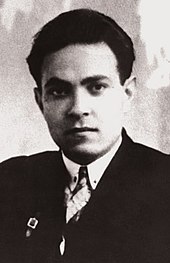Səid Armmov
Səid Əli oğlu Rüstəmov (also Säid Rüstämov Russian Саид Али оглы Рустамов , born Mircabbar Mirəli oğlu Seyidrüstəmzadə * 12. May 1907 in Yerevan , Russian Empire ; † 10. June 1983 in Baku , Azerbaijan SSR ) was a Soviet composer , conductor and music educator of Azerbaijani origin.
life and work
Səid Rustmov lost his father at an early age. Hence, his brothers took care of him. He grew up with them in Yerevan. During the unrest in 1918, his family had to flee to Turkey . They returned to Yerevan shortly afterwards, but had to leave Yerevan for good after their house was destroyed. First it went to Gəncə , later to Ağdaş . The years in Ağdaş sparked his interest in music. He also learned to play the piano. In 1923, the music-loving young man went to Baku with his family and entered the teachers' college and received trumpet lessons. Üzeyir Hacıbəyov , was made aware of the young man by a teacher who taught at the seminary and caused him to be accepted into the mugham class of Mirzə Mansur Mansurov (1887–1967) in the department of folk instruments of the music school and the string instrument Tar learned. He graduated from the music technology school in 1929. A year earlier he had been assigned to teach Tar at the music school. In 1930 he made his first musical composition. The hymn Pioner based on a text by Səməd Vurğun . In 1932 he graduated from the Faculty of Chemistry at the Pedagogical Institute of Azerbaijan. In 1931 Üzeyir Hacıbəyov Azərbaycan Dövlət Xalq Çalğı Alətləri Orkestri , the Azerbaijani State Orchestra for Folk Instruments , founded . Rustmov was the orchestra's concertmaster from the start and its artistic director and chief conductor from 1935 to 1975. He began composing in the 1930s. He wrote Bayatı-kürd, a fantasy based on a mugham for the folk instrument orchestra. Later he composed several pieces for the orchestra, Cəngi and Qəhrəmani, three suites, a concerto for tar and orchestra and several cantatas. He also excelled in composing songs. Examples are Alagöz, Qurban adına, Bənövşə and Haradasan. The songs Sürəyya, Mən sülhə səs verirəm [I vote for peace] and Sumqayıt were awarded the state prize. He also played an important role in the development of musical comedy in Azerbaijan. He wrote the first operettas on modern subjects. These include Beş manatlıq gəlin , Durna , Rəisin arvadı [the boss's wife]. Since the early 1930s he has been teaching at the music technology center in Baku. Since 1957 he has been teaching a tark class in the folk music department at the Azerbaijan State Conservatory. He later headed the department and received the first professorship in the department. In 1935 he wrote the first textbook for teaching the tar string instrument, the Tar məktəbi [Tarschule] and in 1950 Tar üçün melodik etüdlər [Melodic Etudes for Tar]. He had previously published the Skripka əlifbası [Violin Alphabet] in 1948 . He translated several musical textbooks into the Azerbaijani language, such as the harmony theory Nikolai Rimski-Korsakows , collected folk music and published the collections Rəng and Azərbaycan xalq rəqsləri [Azerbaijani folk dances]. He also prepared the song collection 300 xalq mahnısı [300 folk songs], which was edited by the Azerbaijani singer and vocal teacher Bülbül. From 1934 he was a member of the Association of Azerbaijani Composers, later also a board member of the association. In 1938 he was awarded the honorary title of Honored Artist of the Azerbaijani SSR . From 1945 he was a member of the CPSU. From 1949 to 1953, after Üzeyir Hacıbəyov's death, he was chairman of the Azerbaijani SSR Composers' Union. In 1946 he was awarded the medal “For the Defense of the Caucasus” and in 1946 the medal “For heroic work in the Great Patriotic War 1941–1945” . In 1951 he was awarded the Stalin Prize. That year he was also the head of the singing and dancing ensemble of the Azerbaijan Philharmonic Society . In 1957 he became a People's Artist of the Azerbaijani SSR . In 1959, the Order of the Red Banner followed the work . In May 1983, Rüstəmov suffered a myocardial infarction . After a stay in hospital, he initially lived in his home in Mərdəkan , but his condition worsened again and he died on June 10, 1983 in Baku. He was buried on the Fəxri Xiyaban in Baku.
Commemoration
The Azərbaycan Dövlət Xalq Çalğı Alətləri Orkestri , the Azerbaijan State Orchestra for Folk Instruments, is named after him in honor of Səid Rüstəmov.
Web links
Individual evidence
- ↑ a b c d e f g Səadət Təhmirazqızı: Sənətkar ömrü: Səid Rustəmov. In: http://medeniyyet.az . Medeniyyet, May 12, 2010, accessed November 12, 2019 (Azerbaijani).
- ↑ a b c d e Xatirə Qədirova: Əməkdaşlarımızın arxiv araşdırmaları SƏİD RÜSTƏMOV. In: http://www.milliarxiv.gov.az . Azərbaycan Respublikasının Milli Arxiv İdarəsi - National Archives of the Republic of Azerbaijan, February 27, 2018, accessed on November 12, 2019 (Azerbaijani).
- ↑ a b c d Səid Rustəmov. In: http://azcomposersunion.com.az . Azərbaycan Bəstəkarlar İttifaqı, accessed November 11, 2019 (Azerbaijani).
| personal data | |
|---|---|
| SURNAME | Riistmov, Səid |
| ALTERNATIVE NAMES | Rustmov, Səid Əli oğlu; Rustemov, Säid; Рустамов, Саид Али оглы (Russian) |
| BRIEF DESCRIPTION | Azerbaijani composer, conductor and music teacher |
| DATE OF BIRTH | May 12, 1907 |
| PLACE OF BIRTH | Yerevan , Russian Empire |
| DATE OF DEATH | June 10, 1983 |
| Place of death | Baku , Azerbaijani SSR |

